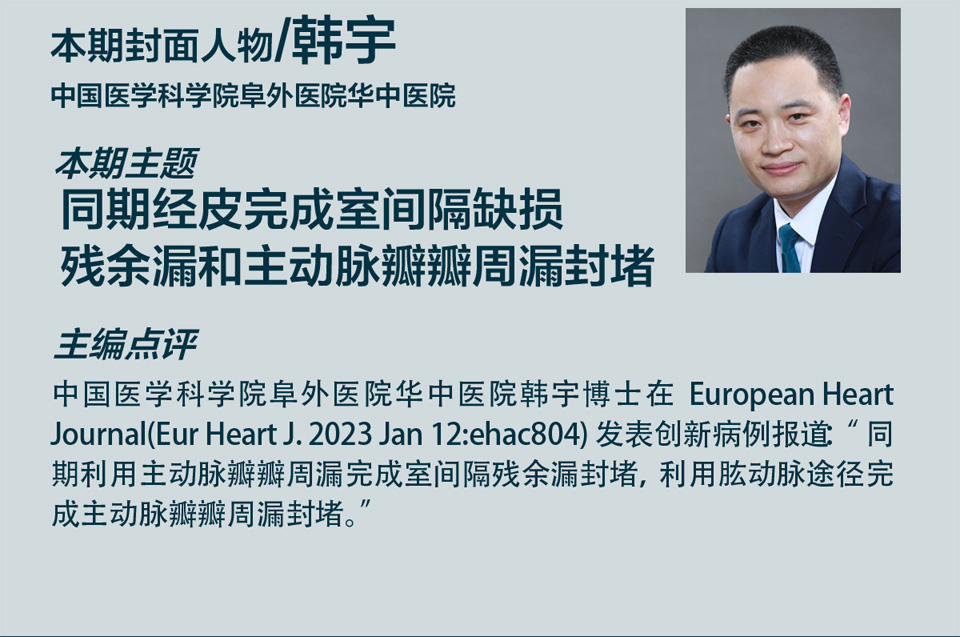
一位42岁男性病人,2年前行室间隔缺损修补和主动脉瓣机械瓣置换术。超声心动图提示紧邻主动脉瓣处存在4.9mm的室缺残余分流,心脏CT结果提示室缺残余分流和可疑主动脉瓣瓣周漏。基于心脏CT的3D重建结果显示存在室缺残余漏和主动脉瓣瓣周漏。
即使应用5F导管通过主动脉瓣机械瓣,血压就不能维持,所以就尝试通过主动脉瓣瓣周漏进入左心室,引导导丝顺利通过瓣周漏进入左心室,通过左心室造影,最终明确了室缺残余分流的位置和大小,通过人工塑形的猪尾导管,终于将引导导丝通过室缺残余漏从左心室送入到右心室,并成功地建立了股动脉到股静脉的轨道。沿着这一轨道,8F输送鞘管通过股静脉送至左心室,应用一个7mm对称的室间隔缺损封堵器成功封堵室缺残余漏。
通过股动脉途径封堵主动脉瓣瓣周漏,所有的输送鞘管长度均无法满足,所以我们穿刺肱动脉,应用雅培ADO-II封堵器成功完成主动脉瓣瓣周漏封堵。术后超声心动图提示2个封堵器的位置和形态良好,室缺残余漏和主动脉瓣瓣周漏消失,主动脉瓣机械瓣未受到封堵器影响,功能正常。
我们首次报道了同期经皮封堵室间隔缺损残余漏和主动脉瓣机械瓣瓣周漏的病例。
中国医学科学院阜外医院华中医院韩宇博士在European Heart Journal发表创新性病例报道:借助主动脉瓣瓣周漏完成室间隔缺损残余漏封堵,最后通过肱动脉又完成主动脉瓣瓣周漏封堵,同期完成室间隔缺损残余漏封堵和主动脉瓣瓣周漏封堵。
既往认为,室间隔缺损残余漏往往位置特殊且形态不规则,经皮封堵极其困难,韩宇等报道的该病例又是主动脉瓣机械瓣置换术后的患者,临床工作中,常规经皮封堵室间隔缺损,必须通过主动脉瓣建立股动脉和股静脉的轨道,该患者即使5F的导管通过主动脉瓣,血压就无法维持,说明常规的方法行不通,意味着患者可能无法通过介入的方法治疗,需要再次外科开刀手术。韩宇博士大胆创新,借助主动脉瓣瓣周漏完成左心室造影,明确室间隔缺损残余分流地位置和大小,通过瓣周漏建立轨道,顺利完成室间隔缺损残余漏封堵。现有输送鞘管长度均无法完成从股动脉途径封堵主动脉瓣瓣周漏,再次创新性地从肱动脉入路,完成主动脉瓣瓣周漏封堵。
同期经皮完成室间隔缺损残余漏封堵和主动脉瓣瓣周漏封堵,避免了患者再次外科开胸手术,为临床上该类患者的微创介入治疗提供了新思路。
A 42-year-old man with a history of ventricular septal defect (VSD) repair and mechanical aortic valve (AV) replacement 2 years ago. Echocardiography showed a 4.9mm ventricular residual shunt (RS) adjacent to aortic valve, and 3D reconstruction based on CT scan clearly showed the RS and an ambiguous paravalvular leak (PVL).
Because hemodynamic instability occurred when passing through the AV with even a 5 Fr catheter, we decided to pass the catheter into the left ventricle (LV) via the PVL for exploring the defects. A guidewirewas successfully inserted to LV through the PVL, and the location and size of the RS were finally determined. With the help of an artificially shaped pigtail catheter, the guidewire was eventually introduced from LV to right ventricle through the RS, and was used to make an arteriovenous loop. A long this loop, an 8Fr delivery sheath was advanced from venous access to the LV. An optimal symmetrical 7mm VSD occluder was then deployed, successfully sealing the RS.
All available delivery sheaths were too short to occlude the PVL via a femoral artery. So a brachial artery was used to occlude the PVL by ADO-II.
An echocardiography post the procedure revealed that two occluders respectively placed for VSD residual shunt and PVL were well seated without peri-device flow, and that the mechanical AV functioned normal. Herein, we describe the first case of simultaneous percutaneous closure of mechanical aortic PVL and VSD residual shunt.
Dr. Han Yu , Central China Hospital, Fuwai Hospital, Chinese Academy of Medical Sciences reported an innovative case in European Heart Journal: the residual leakage of the ventricular septal defect was sealed with a closure device that was passed into left ventricle through the aortic valve leakage, and closure of the aortic valve leakage was subsequently completed through the brachial artery. Both the procedure for sealing the residual leakage of the ventricular septal defect and the aortic valve leakage were completed at the same time.
Dr. Han Yu made a bold innovation to complete the left ventricle ventriculogram with utilizing the periaortic valve leak, defined the location and size of the residual shunt of the ventricular septal defect, and established the route to successfully complete the occluding of the residual leakage through the periaortic valve leak. Another difficulty was that none of the existing delivery sheaths is long enough to complete the closure of the aortic valve from the femoral artery. Again, Dr Han Yu intelligently used the brachial artery and smoothly completed the closure of the aortic valve leakage.
In the report, this novel approach in Central China Hospital, Fuwai Hospital, Chinese Academy of Medical Sciences provides a new idea for simultaneous repair of complicated ventricular septal defect and periaortic valve leakage with the minimally invasive interventional method in clinical practice.
Han Y, Sun Z, Fan T. Simultaneous percutaneous closure of aortic paravalvular leak and residual shunt of ventricular septal defect. Eur Heart J. 2023 Jan 12:ehac804. doi: 10.1093/eurheartj/ehac804.
韩宇,医学博士,副主任医师,硕士研究生导师,英国圣托马斯医院访问学者 , 国家卫健委结构性心脏 病介入培训导师。专业方向:结构性心脏病介入治疗,尤其是单纯超声引导下常见先天性心脏病介入治 疗,经导管主动脉瓣置换、经导管二尖瓣钳夹、经导管三尖瓣钳夹和经导管肺动脉瓣置换等。主持国家 自然科学基金及省部级以上课题 6 项。近 5 年以第一或通讯作者发表 SCI 及中华核心论文 30 余篇。
邮箱:structure_han@126.com
Yu Han,doctor of medicine, associate chief physician and supervisor of postgraduate. He was a visiting scholar of St. Thomas' Hospital, UK, and serves as an interventional training tutor in structural heart diseases for the National Health Commission of China. Professional directions: including the interventional therapy of structural heart diseases, specifically the interventional therapy for common congenital heart diseases under ultrasound guidance, transcatheter aortic valve replacement (TAVR), transcatheter mitral valve clamp, transcatheter tricuspid valve clamp and transcatheter pulmonary valve replacement, etc. He, as principle investigator, currently has 6 research projects at national Natural Science Foundation, provincial and ministerial levels. In the past 5 years, he has published more than 30 SCI and Chinese core papers as the first or corresponding author.